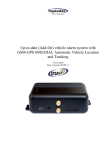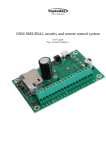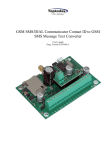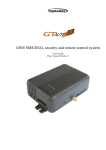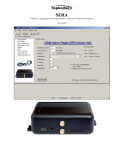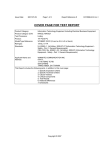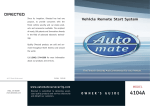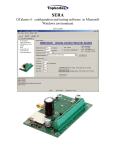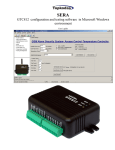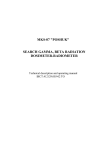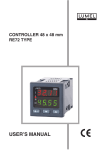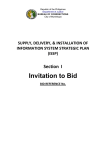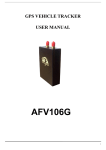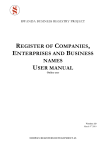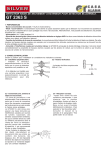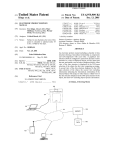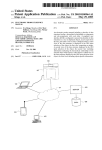Download user manual
Transcript
UAB „Topkodas“ GSM SMS/DIAL security and remote control system User‟s guide Prog. Version GTAUTO v4 APPLICATION The module may be applied for remote monitoring and control of vehicles, motorcycles, boats or other transport facilities as well as for their protection via GSM network. For remote monitoring of premises and for control via GSM network. Remote control of the devices via GSM network Access control. Gate/door control. Automation of premises, temperature and voltage control. GSM thermostat for premisses and heating systems. Remote voice listening. FEATURES Adaptive control of alarm system: ARM/DISARM. Not necessary additional key switch. The module may turned ON/OFF by using manufacturer's central lock. 6 inputs. Fully programmable zones. 2 inputs for arm/disarm the security system. The module can be controlled using standard central lock of a vehicle or using other access control device. 4 programmable 1.5 OC outputs for remote control or for fulfilment of selected function. 1 output for monitoring of system‟s state. LED indicator. 16 users who receive information about protected object. Reception of information in a form of SMS or via DIAL short call. 400 users being able to control gate or electromagnetic lock via free short call. ARM/DISARM of the system via free short call. ARM/DISARM of the system with the factory remote control central lock. Temperature measurement. For temperature control, tracking, alarm and control. Voltage measurement. Voltage monitoring and alarm. External microphone. Remote voice listening option via external microphone. Option to connect BELL for sound alarm. System state BUZZER. (Optional output type) FLASH feature may be used for direction indicators on arming or disarming or in the event of alarm. (Optional output type) Sending of periodical test including system parameters. SMS about state of each sensor, alarms, power supply voltage and GSM communication level. Built-in GSM module. Testing and diagnostic of the module via USB by using program SERA Remote set-up via SMS messages. Configuration of the module via USB. Standard mini USB cable may be used Free configuration program SERA. Very compact Automated GSM security and control system www.topkodas.lt 2 Content 1. 2. 3. 4. 5. 6. 7. Safety requirements .................................................................................................................................................. 4 Application of the device .......................................................................................................................................... 4 Used definitions and terms ........................................................................................................................................ 4 Short description of the operation principle .............................................................................................................. 4 Package content ........................................................................................................................................................ 5 Specifications ............................................................................................................................................................ 6 General view of the product and layout of control devices ....................................................................................... 7 7.1. Input/output connector pinouts meaning and layout....................................................................................... 8 8. Users ......................................................................................................................................................................... 9 8.1. Control and programming of the module via SMS messages ......................................................................... 9 8.1.1. Installer ....................................................................................................................................................... 9 8.1.2. User ............................................................................................................................................................ 9 8.2. Users to receive SMS/DIAL messages ............................................................................................................ 9 8.3. Remote control. Users who are able to control the module via short call. ...................................................... 9 9. Temperature control and maintenance Heating and cooling system control ........................................................... 10 9.1. Premisses automation, temperature controller installation and connection diagram ..................................... 11 9.2. Remote temperature control via SMS messages ........................................................................................... 12 10. ARM/DISARM of the module ................................................................................................................................ 12 10.1. ARM/DISARM via short call ........................................................................................................................ 12 10.2. ARM/DISARM by sending SMS message ................................................................................................... 12 10.3. ARM/DISARM by using Lock and Unlock inputs ....................................................................................... 12 10.4. Usage of Lock/Unlock IN4, IN6 inputs with lock/unlock feature ................................................................. 13 10.5. Automatic arming of the security system “Auto rearm” ............................................................................... 14 10.6. Enabling of the security system via IN6 input. „Force ARMing“ function ................................................... 14 10.7. “Blocking ARM” IN5 additional feature ....................................................................................................... 14 10.8. Bell confirmation signal by arming/disarming the security system ............................................................... 14 11. Module inputs ......................................................................................................................................................... 14 11.1. Equivalent input diagrams ............................................................................................................................. 15 11.2. Sensor connection diagrams .......................................................................................................................... 15 11.3. Input configuration parameters...................................................................................................................... 16 11.4. Voltage measuring IN7 (internal) .................................................................................................................. 16 11.5. Microphone and voice listening .................................................................................................................... 16 12. Programmable outputs ............................................................................................................................................ 17 12.1. Equivalent output diagrams ........................................................................................................................... 17 12.2. Output connection diagrams .......................................................................................................................... 17 12.3. Operational output parameters ...................................................................................................................... 17 13. Timers of the security system ................................................................................................................................. 17 14. Automatic periodical test sending ........................................................................................................................... 18 15. Messages sending ................................................................................................................................................... 18 16. Remote control of the module via SMS messages or via short call ........................................................................ 18 17. Preparation to operate ............................................................................................................................................. 18 17.1. SIM card ........................................................................................................................................................ 19 17.2. Configuration and control of GSM communication module via SMS messages .......................................... 19 17.3. Configuration of the module via PC .............................................................................................................. 26 17.4. Installation of the product and connection diagram....................................................................................... 26 17.5. Installation instruction and connection diagram of security system for house, mini-mobile cottages, boats 26 17.6. Vehicle's GSM messages system Installation manual and connection diagram ............................................ 27 17.7. Testing and diagnostics ................................................................................................................................. 30 18. Software updating ................................................................................................................................................... 30 Annexes ............................................................................................................................................................................ 31 1. Annex. ..................................................................................................................................................................... 31 2. Annex ...................................................................................................................................................................... 32 Automated GSM security and control system www.topkodas.lt 3 1. Safety requirements Before applying the module in operation please read this user's guide. Any operations, related with mounting of the module and connecting of peripheral devices, should be performed only after unplugging the module from the mains. 2. Application of the device GSM security module GTAUTO (hereinafter the Module) is applied for transferring of GSM SMS messages to the mobile phone of a user. GTAUTO module may be used for protection of various vehicles. The module may be used for protection of a vehicle or in combination with the vehicle's security system, which has control lock control. The module may be applied for protection of house, garages, cottages, vehicles as well as for access control, gate control, objects' automation, smart house and temperature control. For premisses protection and many other applications. In the event of burglary, the device, depending on programmed operation algorithm, is able to call or to send SMS to up to 16 users. A user is able to hear what is going on premises after answering a call or he may make a call by himself. A user is able to receive an SMS with detailed information about status of each protected zone and number of alarm events. The user is able to control the device via SMS messages only if he knows user's password. If a call is being performed from the telephone number not included in the system„s data base, the call is rejected immediately. The module has system voltage control. If power supply voltage drops below the defined value, a user automatically will be notified via SMS. The SMS message includes voltage of backup battery (System Voltage). The module has external temperature sensor. A user receives information about temperature alarms and restores via SMS messages. The SMS on voltage of the module and ambient temperature is also available. Temperature may be measured in Celsius and Fahrenheit. SMS periodical test ensures constant control of the module. The module is able to send periodical test. Test time is programmable. The test will include all essential information: GSM communication strength, system (car battery's) power supply voltage, temperature and IMEI of the module. GTAUTO module is ideal for remote vehicle start-up. The module compares incoming number with programmed users' numbers and in a case of coincide activates an output or other action and interrupts the call automatically. All parameters of the module should be configured via PC by using software SERA or in remote manner by sending appropriate SMS including password. 3. Used definitions and terms Installer – a person provided with INST (installer's) password. User - is a person being aware USER password. Authorized user - is a person whose mobile phone‟s number is entered in GSM module. Two authorized users with the same rights may be entered into the module. Configuration - programming of the settings, which will define the operation of the item. For example, user's telephone numbers, set-up of periodicity for sending SMS message, input names etc. Event - event a user receives the information about. ARM - status of the security system. The module is in ARM mode DISARM - status of the security system. The module is in standby mode; only 24h inputs are active. NO - input type (Normal Open) - this means that the alarm will be send when the input will be connected with ground (-V). NC - input type (Normal Close) - this means that the alarm will be send when the circuit between input and ground (-V) will be broken. EOL - (end of line resistor) input type with resistor. Service messages– ARM/DISARM, test, resetting of the system. DIAL- the system makes a call to the number specified. Pull-up resistor - is that it weakly "pulls" the voltage of the wire it is connected to towards +V (or whatever voltage represents logic "high"). MIC - microphone COM – negative power supply terminal. +V - positive power supply terminal. SSR- Solid State Relay Caller ID - Caller's identification 4. Short description of the operation principle GTauto (further referred to as the module) transfers messages about events of the security system to the mobile phone of a user via GSM communication channel. Upon alarm response of the security system, the module will generate SMS message about alarmed sensors: door, capote, shock, fuel tank etc. SMS message is being sent to a user in-line with a short call. This is to reduce the probability that a user will not observe SMS message. It is possible to send SMS and to call to 16 users. The algorithm of message sending is SMS1,SMS2...SMSn till all SMS messages will be send. After DIAL1,DIAL2....DIALn. All messages are being sent until all users will be Automated GSM security and control system www.topkodas.lt 4 notified about the event. Preferred messages and texts of these messages should be defined when programming the module. The module understands when the call is rejected and will not repeat calling. When the module is calling to the user‟s phone, the user can not reject the call at least 15 seconds. Otherwise the module will understand that the user„s number is busy and will try to repeat the call again. In a case the user„s number is busy in fact, the module will make repetitive calls following the programmed number of calls. Note: Efficiency of this function depends on interpretation of call control by the operator; in some cases the operator may wrongly interpret the call and thus the module will make repetitive calls each 60 seconds, following the programmed number of repetitions (by default 3 repetitions). In such case GSM operator may be changed or simply the amount of DIAL repetitions reduced. Parameters of the module are set by sending SMS or via PC by using standard miniUSB cable and configuration software SERA, which is available to download at www.topkodas.lt.Page In order to activate voice listening it is necessary to call from a user„s telephone number. When calling, the module will immediately activate voice listening, which will last as long as the user will reject the call or when the module will start performing other commands. Calls from other telephone numbers (of non-authorized users) are ignored. 5. Package content ` Or GTAUTO module - 1 pcs System state indicator (LED), attached on the system cable - 1 pcs Mini USB cable System cable - 1pcs GSM antenna - 1 pcs 2,2 kOhm resistors - 4 pcs 1 kOhm resistors - 6 pcs External temperature sensor, attached on the system cable - 1 pcs Mini CD - 1 pcs: User‟s guide in PDF Program SERA USB drivers External microphone attached on the system cable - 1 pcs Shipping Package Note: Some package content may be optional. Please ask seller for more information. Automated GSM security and control system www.topkodas.lt 5 6. Specifications Parameters of built-in GSM module: Quad-band (850/900/1800/1900 MHz) Sending of SMS messages Receiving of calls and dialling Microphone Outputs: OUT1 - OUT4 max current - .................................................................. (-V) 1500 mA. OUT1-OUT4 are protected from overvoltage, overcurrent and overhearting. All outputs can be controlled via short call DIAL or via SMS message. This feature may be used for gate opening, ignition locking etc. Output alarm parameters may be programmed. Programmable algorithms for outputs operation: CTRL/SMS/DIAL, SIREN, BUZER, ARM state, Zones OK, Light Flash,inverting ,pulse mode INI-IN6 inputs: SMS text for input alarm and restore Programmable enabling or disabling of inputs; Input type NC/NO/EOL Algorithm for zones operation:: delay, interior, instant, 24 hours, silent, fire Response time; Time of additional response; Commutation of selected out put IN7 voltage control (internal power supply voltage input) Alarm voltage (programmable); Restore voltage (programmable); Programming-based voltage calibration; Power supply voltage range ................................................................... from 8.0 V to 16 V. Measurement scale ................................................................................ 0.01V; Temperature control parameters: External temperature sensor; Alarm temperature (programmable); Restore temperature (programmable); Programming-based calibration of temperature sensor; Temperature measurement range ........................................................... from -40 oC to +80 oC Measurement system ............................................................................. Fahrenheit/Celsius Measurement scale ................................................................................ 0.1 oC / 0.18 oF Module control: ARM/DISARM of the security system via LOCK/UNLOCK outputs. 6 control algorithms: Two condition inputs, used via SMS message via short call DIAL Automatic periodical test: Test sending in a form of SMS message. Sending communication control messages (tests) at time range from 1 to 24 hours after pressing RESET button or after entering into ARM (security) mode. Settings discreetness - one hour. Power supply voltage: Nominal power supply voltage .............................................................. 12.6 V Power supply voltage range ................................................................... 9 - 16 V Consumption current: In standby mode................ ..................................................................... less than 30 mA*. In dialling or SMS sending mode .............................. ............................ less than 300 mA. Environmental parameters: Storage temperature range from ............................................................ -40 to +85 oC / -40 iki 185 oF Operational temperature range from ...................................................... -30 to +75 oC / from -22 to 167 oF Max relative humidity under +40 oC / 104 oF ....................................... 95% Automated GSM security and control system www.topkodas.lt 6 Package weight:............................................................................................. 430g Module weight: ............................................................................................. 112g Overall dimensions of the module: ............................................................... 90x63x32 mm * Current consumption in idle running depends on inputs connection type, on output state and load. 7. General view of the product and layout of control devices 1. 2. 3. 4. 5. 6. 7. REG (yellow) LED WDG (green) LED MOD (red) LED MiniUSB programming connector RESET button GSM antenna connector SIM card holder of "Push-Push" type 9 Power supply and input/output connector Automated GSM security and control system www.topkodas.lt 7 7-1 Meaning of LEDs Name External LED on the system cable “ARM state” WDG (green) built-in LED REG (yellow) built-in LED MOD (red) built-in LED WDG/REG Indication variations Flashes, remains lit for 50ms, turns off for 300ms. Blinking, remains lit for 50ms, turns off for 10s. Off Blinking, remains lit for 50ms, turns off after 1000ms. Off Lights continuously Flashes, remains lit for 50ms, turns off for 300ms. Off Flashes Lights continuously Off Turns on each 500 ms Meaning GSM module is in ARM (security) mode. GSM module is in DISARM (non-security) mode. Program error, processor is out of order, hardware problem or power supply failure. The module is functioning. The module is out of order or no voltage. Modem has been registered to the network. Modem is being registered to the GSM network. Modem failed to register to the network. Power supply OK and the module is registered to the GSM network. Modem power supply is OK, but the module failed to register to the GSM network. Modem power supply failure or it is switched off. The Bootloader mode In this mode it is possible to update the firmware of the module Name Contact No 7.1. Input/output connector pinouts meaning and layout Wire colour Description 1 11 2 12 3 13 4 14 5 15 6 16 7 17 8 18 GND +V Input 1 Input 2 Input 3 Input 4 Input 5 Input 6 Lock Unlock OUT1 OUT2 OUT3 OUT4 LED(K) LED(A) Black Red Green/Yellow Green Yellow Brown Blue Orange Black/White Black Grey Green/Yellow Green White Black/White Black Negative supply voltage (GND) Positive supply voltage Power supply voltage 8-16V 1 zones/input, NC/NO/EOL 2 zones/input, NC/NO/EOL 3 zones/input, NC/NO/EOL 4 zones/input, NC/NO/EOL 5 zones/input, NC/NO/EOL 6 zones/input, NC/NO/EOL Input for security ARMING Input for security DISARMING First output 1500mA. Open Collector. Second output 1500mA. Open Collector. First output 1500mA. Open Collector. Second output 1500mA. Open Collector. ARM/DISARM state LED cathode ARM/DISARM state LED anode 9 19 10 20 Temp+ TempMICP MICN Black/White Black Black/White Black Temperature sensor input Temperature sensor input Positive differential input of the microphone. Negative differential input of the microphone. Automated GSM security and control system www.topkodas.lt 8 8. Users 8.1. Control and programming of the module via SMS messages 8.1.1. Installer Installer is able to execute all (INST) commands available in the table17-1. The installer is able to change parameters of the module only with INST password 8.1.2. User User is able to execute only user‟s (USER) commands available in the table17-2. A User may send SMS request any time and receive parameters of the security system: zones and inputs states, communication strength, temperature etc. SMS messages may be used to control outputs (Out1, Out2, Out3, Out4) and to activate ARM/DISARM mode.. A User is able to control the module only when using USER password. 8.2. Users to receive SMS/DIAL messages The number of users - up to 16 These users are able to receive messages or/and calls after alarm response of the security system or communication test or system state test messages, which are being generated after alarm response of the security system or following test messages schedule. The number of users - up to 16 It is possible to select, what event SMS to be send to each user. 8.3. Remote control. Users who are able to control the module via short call. The number of users - up to 400 These users are able to control outputs via short call, to activate voice listening and to activate ARM/DISARM mode of the system. Action of the user is free-to-select. The actions to be done by the module, after the telephone number having been recognized, might be assigned to every telephone number. The following actions may be selected regarding telephone number of each user: To activate outputs OUT1,OUT2,OUT3,OUT4 optionally. This function might be used to lock a vehicle's ignition, to start a vehicle and for remote control of other equipment. ARM/DISARM security system Activate voice listening via external microphone MIC Automated GSM security and control system www.topkodas.lt 9 9. Temperature control and maintenance Heating and cooling system control Temperature control with GSM phones GTauto thermostat measure temperature through a probe (that is on system cable) and can drive any of outputs OUT1, OUT2, OUT3 , OUT4 (you can program which) to activate or deactivate the heating/cooling system so to keep the temperature required. This is the way to keep room temperature required. Temperature range is -40 to 80 degrees Celsius or accordingly Fahrenheit. It is possible to set a low temperature alarm and a high temperature alarm. Passage through these thresholds will trigger alarm SMSs. You can choose a temperature hysteresis. If the temperature is too low or too high the Module will send SMS message including warning and actual temperature value. allowing you to take action or a output to be activated to correct the temperature. For example a user can receive a reporting SMS and also switch output on or off to achieve the requested temperate. This is quite powerful temperature control system not only for residential use but for professional use only. If your company sells heating on a calories basis, this solution can help you a lot, avoiding energy waste and useless trips to a location. If you have a house in the mountains and want to make sure temperature is kept correctly. GTauto is a professional solution to implement this decision. Module can be used to monitor industrial refrigerators, electrical transformers animal farms or any location or machine where temperature control is significant. Temperature controller configuration window. Temperature sensor is connected to the system wire contacts 9 Temp(+) and 19 Temp(-). Alarm and restore temperature may be changed. Upon temperature alarm, the module will send SMS message to a user. And if setting exist, the module will switch the selected output. It is comfortable to use this function for indoor heating management. In a case of accuracy shortage, temperature sensor may be calibrated additionally. Following the equation Temperature=X*ADC+Y and by selecting X and Y coefficients. Temperature calibration may be performed in software SERA in testing window. It is necessary to have accurate thermometer in order to measure temperature at least in two points. In testing window to read temperature ADC indications in these points. Following the equation “Temperature=X*ADC+Y“ to calculate X and Y coefficients. Calculated X and Y coefficients should be programmed in the module. It is easy to calculate X and Y coefficients in MC Excel by using trendline. y = 0,3284x - 269,26 40 35 30 Teperature 25 20 15 10 5 0 800,00 -5 820,00 840,00 860,00 880,00 900,00 920,00 940,00 ADC Temperature may be measured in Celsius and Fahrenheit. Automated GSM security and control system www.topkodas.lt 10 9.1. Premisses automation, temperature controller installation and connection diagram Preparation of the module for operation by using configuration software (pictures and the more detailed info are available in SERA description): Define parameters of the outputs. Output state SMS text, output operation description (OUT definition) „CTRL/SMS/DIAL“, state type (State mode)- Steady. If necessary output operation might be inverted. In the GSM communication window parameters of the users to send SMS and DIAL should be set. Also check boxes should be checked to send SMS and DIAL to a user about temperature alarms. In GSM remote control window telephone numbers of users, who will be able to control selected outputs via free short call , should be entered. On The "Temperature Controller Settings" window, set the cooler device temperature control settings: o Cooling temperature value "High temperature" o Cooling hysteresis o Select cooler control output (OUT1-OUT4) or disable, if cooler device is not used. o Determine the temperature value at which will be sent an SMS overheat temperature alarm o Determine the temperature at which the value will be sent an SMS temperature alarm o If you want to receive overheat alarm, need to check box "Enable" Similar settings are done with heater control options. In order to control big power alternating current equipment, it is comfortable to use solid state relays. Standard AC/DC adapter with the voltage 10V-14V and current >=1A might be used to powering the module. Attention! AC equipment can not be connected directly to the module. It is necessary to use a special relays or other methods, which are in compliance with electrical safety requirements. Attention! When controlling devices from the AC network , it is necessary to follow all electrical safety requirements. Module connection scheme to control heating or cooling equipment: Cooling Device/Air Conditioner High Voltage AC 85-260V DC 85-260V ~ ~ - + 5-24V Input SSR Output ~ ~ - + Solid State Relay DC 10-14V, >1A 5-24V Input GND - +12V Cooler Control (OUT1) GND +V Heater Control (OUT2) FUSE 5A + AC / D C a d a p ter 1 0 -1 4 V, >1 A SSR Output Black Black/ White Black Black/ White Black Black/ White White Green Green/Yellow Grey Black Black/ White Orange Blue Brown Yellow Green Green/Yellow Red Black 20 10 19 9 18 8 17 7 16 6 15 5 14 4 13 3 12 2 11 1 Temperature Sensor MICN MICP Temp(-) Temp(+) Led(A) Led(K) Out4(1. 5 A) Out3(1. 5 A) Out2(1. 5 A) Out1(1. 5 A) In8_Unlock In7_Lock In6_Siren In5_Ignition In4_S hock In3_Door In2_Eng_Bonnet In1_Luggage +13. 5V GND 20 10 19 9 18 8 17 7 16 6 15 5 14 4 13 3 12 2 11 1 Furnance/Heater +12V Automated GSM security and control system www.topkodas.lt 11 9.2. Remote temperature control via SMS messages Temperature may be changed in remote manner by using SMS commands. Overheating temperature value upon reaching which, the following SMS message will be sent: „High temperature alarm“. INST123456˽70˽35.5# INST - user type (installer) 123456 – user code space character 70 - the command to change overheating temperature alarm value space character 35.5# - overheating alarm temperature value. The end symbol # Freezing temperature value upon reaching which, the following SMS message will be sent: „Low temperature alarm“. INST123456˽71˽5.5# Temperature value for freezing equipment control. INST123456˽72˽28.5# Temperature value for heating equipment control. INST123456˽73˽21.7# More information about SMS commands see chapter 17.2 10. ARM/DISARM of the module The module can work in ARM mode and DISARM mode. ARM/DISARM state of the module may be changed thus: via short call, via SMS message and by using Lock/Unlock inputs. All modes of ARM/DISARM may supplement each other. For example: The module may be activated via Lock/Unlock inputs, and deactivated via short call or SMS message. 10.1. ARM/DISARM via short call It is possible for 400 users to activate/deactivate the module via short call. The module will recognize user„s number and will automatically cancel the call. Not recognized numbers are being ignored. Information on how to program the user numbers is available in the description of SERA. 10.2. ARM/DISARM by sending SMS message It is possible to ARM/DISARM of the module by sending SMS message and using USER or INST password. Example of SMS message: To ARM the system: USER123456˽59˽0 To DISARM the system: USER123456˽59˽1 More info see 17.2 10.3. ARM/DISARM by using Lock and Unlock inputs It is possible to ARM/DISARM the module by using Lock and Unlock inputs. These inputs may be used when it is necessary to control the module via any additional external access control device having NO or NC output: Vehicle's central lock signal; Access control device, e.g.: RFID, IBUTTON, keyboard; It is possible to use switch, button, reed switch etc. for generating of control signal. Several Lock/Unlock modes are available: Mode 1 (V+ Pulse using Lock and Unlock inputs). Lock input sets ARM mode after pulsing or steady signal. Unlock sets DISARM mode. It is comfortable to use 1st or 2nd mode when connecting the Automated GSM security and control system www.topkodas.lt 12 module to the central lock of vehicle. Central lock mostly generates lock and unlock signals with two wires. 2nd mode 2 (V- Pulse using Lock and Unlock inputs) similar as 1 mode only inverted. 3rd mode 3 (V+ Level using Lock input) used only one Lock input. Unlock input is not used. These modes are comfortable to use when activating/deactivating the system by using switch or other access control device. 4th mode (V- Level using Lock and Unlock inputs) similar as 3rd mode is only inverted. 5th mode (V+ + >500ms Pulse Lock input) uses only one Lock input. Unlock input is not used. The ARM/DISARM state might be changed via voltage pulse longer than 500ms. The voltage pulse might be generated by using switch or other input control device. 6th mode (V+ >500ms Pulse Lock input) similar as 5th mode is only inverted. 1,2,3,4,5,6 see diagrams in annex 2. Lock and Unlock inputs do not have built-in Pull-Up resistor. When there is no external signal, you need to connect external 2,2K pull-up resistor. The resistor should be connected between power supply positive terminal +V and input. Such event may occur when switch is connected between lock input and ground as shown in Fig. 10-1Fig. 10-1 Example of wiring diagram with two switches. One switch for ARM-ing, another - DISARM-ing. 1st or 2nd modes should be set by using two switches. +V GTauto Pull Up resistor 2.2K Lock +V Lock switch Unlock Pull Up resistor 2.2K UnLock switch Fig. 10-1 Example of wiring diagram with central lock of vehicle, see annex 1 10.4. Usage of Lock/Unlock IN4, IN6 inputs with lock/unlock feature Lock/Unlock condition is used when a user does not want the security system to be activated/deactivated, by using door lock or central lock button. In such event the module will analyse signals from door and central lock and will not allow changing ARM/DISARM mode. This feature will protect a vehicle from disabling (DISARMing) the module via the lock or button, in the event of breaking window and pressing central lock button or lock spinning. For lock/unlock blocking condition it is necessary to use IN4 or/and IN6 module inputs. These inputs are configured like additional input function. The following conditions might be set: Unlock Blocking condition Lock Blocking condition Lock/Unlock Blocking condition Automated GSM security and control system www.topkodas.lt 13 +V GTauto GTauto UnLock Condition 13 +V Door lock contact for Unocking IN4 +V Lock Condition 14 UnLock Condition 13 Central lock switch contact in passenger compartment for Unlocking +V IN6 +V Pull Up 2.2K Door lock contact for locking +V Pull Up 2.2K Lock Condition 14 Lock Lock signal 15 Unlock +V +V Pull Up 2.2K Lock +V Pull Up 2.2K +V 15 UnLock signal Central lock switch contact in passenger compartment for Unlocking Door lock contact for locking IN6 Central lock switch contact in passenger compartment for locking 5 5 Door lock contact for Unocking IN4 Central lock switch contact in passenger compartment for locking Lock signal Unlock UnLock signal 10.5. Automatic arming of the security system “Auto rearm” If the function „Auto-reARM“ is on, the module will automatically return to ARM state, if during „Entry Delay“ none of zones was alarmed. This feature is active only if the module was deactivated via telephone DIAL or SMS. This protects from casual disabling of the system via telephone. 10.6. Enabling of the security system via IN6 input. „Force ARMing“ function This feature is comfortable to use when the module operates in parallel with other security system. For example, if default security system is used in a vehicle, thus bell signal may be used for IN6 of the GTAUTO module. If default security system will be alarmed for appropriate reasons and will activate the bell, thus GTAUTO module will automatically turn into ARM state. And will send all information in relation to alarmed sensors. Thus the user gains additional protection from undesirable deactivation of GTAUTO module. This IN6 feature may be disabled. 10.7. “Blocking ARM” IN5 additional feature This is additional feature IN5, which enables to block activation of ARM State. This feature may be applied in vehicles by connecting IN5 input to ignition. If GTAUTO module was deactivated and after ignition was turn on thus while the ignition will be on, the module would not be able to enter into ARM state. This feature may be disabled. 10.8. Bell confirmation signal by arming/disarming the security system The siren will generate confirmation signal when arming/disarming the security system, if function „Siren signal on ARM/DISARM“ was selected in the software SERA. When the security system is to be turned in ARM mode, the bell will beep once, when in DISARM mode - the bell will beep twice. 11. Module inputs The module GTAUTO has: 6 programmable external inputs (zones). 1 temperature sensor input. Measuring of power supply voltage. Internal input is visible in programming table. 2 control inputs Lock and Unlock, see clause10.3 . Each input may be linked with selected output, i.e. to switch selected output depending on output state. This feature enables to apply the module for premisses automation and temperature control. For example: For example, Automated GSM security and control system www.topkodas.lt 14 if temperature drops below the standard limit, the module is able to automatically activate heating system and also to inform a user about critical temperature by sending him an SMS. 11.1. Equivalent input diagrams Equivalent 1-4 input diagram: GTALARM +V 2.2K IN1-IN4 5-6 inputs are used when Pull-Up resistor is not necessary for the input. For example, when signal should be taken from vehicle's bell or ignition or from other device, for which extraneous signal cannot be applied. These inputs do not have internal Pull-Up resistor. Input resistance is 22kOhm. Equivalent diagram of 5-6 inputs: GTALARM IN5-IN6 11.2. Sensor connection diagrams Sensors may be connected following 4 different connection diagrams: NC – normally closed contact; NO – normally open contact; NC/EOL – normally closed with end of line resistor, line resistor), NO/EOL – normally closed with end of line resistor, resistor), NOTE. All resistors should be 1 kOm ± 10%. The length of wires for connection of sensors can not exceed 300m and resistance of wire connected to sensor contacts can not exceed 300 Ohms. Resistors should be mounted as near the sensor as possible. Improper connection of resistors system will not work properly. Pull-Up resistors should be 2,2 KOhm. +V IN1-IN4 Pull Up resistor 2.2K IN1-IN4 IN5-IN6 NC COM +V NC Pull Up resistor 2.2K IN5-IN6 NO COM NO COM COM +V IN1-IN4 Pull Up resistor 2.2K IN1-IN4 IN5-IN6 NC/EOL COM +V COM 1K 1K NC/EOL Pull Up resistor 2.2K IN5-IN6 NC/EOL COM 1K NC/EOL COM 1K Automated GSM security and control system www.topkodas.lt 15 11.3. Input configuration parameters The following parameters may be set for all inputs: Text of SMS messages for alarms and restores. This text will be included when sending SMS message to a user about alarms and restores of zones. Input types: NC,NO,EOL. These parameters should be set depending on type of zone connection. Definitions of input application: o Delay – Entry/Exit zone. Set "Entry delay" and "Exit Delay" are applied for this zone. Such type zones are used for connection of door sensor. o Interior – disturbance of this type of the zone will not be responded if alarm of “Delay” type zone occurred and “Entry Dlay” or “Exit Delay” time still have not run out. Such type zones may be used for connection of motion sensor in front of the door. The input will be activated immediately, if the door has not been opened before. o Instant – Instant zone. Upon disturbance of this zone, the system will immediately activate burglary alarm. o 24 hours - Upon disturbance of this zone, the system will activate burglary alarm not depending whether the security system is in ARM or in DISARM modes. The applications of this type zones are safes, storehouses, tampers of the sensors. o Silent - silent zone is always active not depending on whether the security system is ARM or DISARM. Upon disturbance of this zone, SMS messages are being generated but the siren will not be activated. These zones may be applied for voltage, temperature control, AC mains failure control and for alarm of silent panic. o Fire - this zone is always active not depending on whether the security system is ARM or DISARM. The zone generates a special siren signal with interruptions. The zone is applied for smoke sensors and for fire alarm. Enabling or disabling of zone alarm or restore. Input speed – time of the input reaction, this is the time period during which changed input state should remain stable in order to let the module to register alarm or restore input state. Repeat time – this is the time period, during which repeated event of the input will be ignored. Zone action – switching of selected output (OUT1, OUT2, OUT3, OUT4) in the event of alarm or restore. May be used for object automation. For example, for indoor temperature control. Upon dropping of temperature will critical limit, heater would be switched on automatically. 11.4. Voltage measuring IN7 (internal) This input is visible only in configuration window of the SERA software of the module. IN7 input is intended for power supply voltage control. If the module is being applied for the security of vehicle, it is very comfortable to follow cat battery voltage. A user will always be alerted that a car battery has been charged or discharged. This the car battery will be protected from full discharge or damage. Alarm and restore voltages are programmable. Voltage measurement may be calibrated additionally. 11.5. Microphone and voice listening The microphone may be connected to the system wire contacts 10 MICP and 20 MICN. In order to avoid noises, the microphone should be mounted as far as possible from GSM antenna. 400 users are allowed activating voice listening in the objects. In order to allow a user to activate voice listening, it is necessary in user table „GSM remote control“ to check the box „MIC“. Note: If a user number is enabled for ARM/DISARM and MIC thus after making a call to the module, the state ARM or DISARM will be changed and also microphone will be activated. Automated GSM security and control system www.topkodas.lt 16 12. Programmable outputs The module GTAUTO has 4 programmable outputs. Outputs of the module may be used to switch relay, LEDs, siren or other sound device. Current for OUT1 - OUT4 is 1500mA. All outputs are protected from short-circuit, overvoltage and overheating. 12.1. Equivalent output diagrams OUT1 - OUT4 outputs is open collector in terms of grounding –V. All outputs have current limitation from 1.5A, also protection from overvoltage and overhearting. OUT1 - OUT4 equivalent diagram: GTAUTO OUT1-OUT4 COM 12.2. Output connection diagrams Examples of output connection diagrams see below: GTAUTO 1500mA OUT1-OUT4 1500mA OUT1-OUT4 GTAUTO +V COM +V Siren COM 12.3. Operational output parameters The following parameters may be set for each output: SMS text for ON output state SMS text for OFF output state Output operation algorithm „OUT def“: o CTRL/SMS/DIAL – output used for remote control via short call or SMS. E.g. for ignition blocking, for gate control or for remote vehicle starting etc. o SIREN – output used for connection of siren. “Siren time” can be changed. o BUZER – sound signalling device. In the event of zone alarm - beeps continuously. When security system starts calculating exit delay, the user is able to hear short, repetitive sound signals. When 10 seconds are left till the begging of activation, signals are being repeated each 0.5 seconds. If after expiry of the delay time, all zones remain unalarmed, the system turns into ARM state along with beep sound to confirm the action. o ARM state – state of alarm system: ARM/DISARM. May be used for light indication. When the output is set to operate in pulse mode, this feature may be used to close car windows or sunroof on arming. Impulse time should be set 20-30 seconds. On arming the output will generate signal to close windows. o Inputs OK- if any of zones is disturbed, the output will be alarmed. This feature is usually used for indication whether all zones are in order. o Light Flash – used for connection of light signal. Upon alarm of the security system the light starts blinking. Lights will also blink when arming/disarming the security system. This feature may be applied to connect vehicle direction signals. Output inversion; Output type level or impulse; Output impulse duration. 1-65535 seconds. 13. Timers of the security system Entry Delay – time period, during which the user after passing Delay zone should manage to disarm the security system. Exit Delay – time period, during which the user should manage to leave the object and pass Delay zone. Siren time – Siren switch on time in the event of alarm. Test time – time of automatic periodical test. Automated GSM security and control system www.topkodas.lt 17 14. Automatic periodical test sending Periodical test may be used for communication control of the module. Test sending time is programmable [Test Time]. Asynchronous periodical test may be programmed. This means that after each activation of the system, test time is being calculated from the beginning „Reset test counter ARMing“. Test sending may be disabled by setting time 00. Periodical test may be used for SIM card's account control. The following parameters of the module are available in a test message: GSM communication strength, power supply voltage, temperature, IMEI number of the module, software version. 15. Messages sending Messages are being sent in the event of alarm, after ARM/DISARM of the security system (if specified in the configuration), upon test sending time (if specified in the configuration), after changing the module configuration (if specified in the configuration), upon sending request about parameters (command code 80). SMS about alarm of the security system is doubled with a short telephone call (if specified in configuration). 16. Remote control of the module via SMS messages or via short call With the help of SMS messages it is possible to control devices connected to outputs Out1, Out2, Out3, Out4. It is possible to ARM/DISARM the security system. Control command for user (USER) are available in the table No 182. The amount of users when controlling via SMS is unlimited. Example of control command when changes the states of all three outputs and inquiry is made to send information via SMS about output states after changing of output states: USER123456˽51˽52˽53˽80˽5 USER - user type 123456 – installer‟s code; space character 51- changing of the first output state space character 52 – changing of the second output state space character 53 – changing of the third output state space character 80 – information request command (see table No 3) space character 5 – to send information via SMS about output states. More examples of controlling via SMS message see the chapter 17.2 All outputs may be controlled via short call (the module will automatically reject the call). Up to 400 users may control the module. All users optionally may control outputs Out1, Out2, Out3, OUT4, ARM/DISARM the security system and activate voice listening (MIC). It is possible to assign to each user that he is able to control. This is comfortable to use a single module for controlling of few gates when several masters are. 17. Preparation to operate Before or after installation of the module it is necessary to configure its parameters. SIM card settings may be configured by using only GSM phone. How to prepare the module to operate: Connect system connector and GSM antenna. Connect power supply source: 10-15V battery or stabilized 10-15V/1A power supply source. Check and if necessary enter SMS message centre number (using GSM phones). Mostly SIM card already has SMS centre number inserted, please skip this step. Remove PIN code request of the SIM card (it can be done using GSM phone). Install SERA configuration program. Connect USB cable to the PC and to the module. Launch SERA program. Guidelines on how to use SERA program is available in SERA description. GSM communication strength, IMEI and SMS centre number are available in Test window (see SERA description). Configure telephone numbers to which information should be transferred*; Automated GSM security and control system www.topkodas.lt 18 Set the numbers to send SMS and to make a call*; Set active inputs, which will be used; For example, if the input will not be used, it should be disabled*; Set periodicity of communication test (if 00 is entered, the test will not be send); Set input parameters. Set output OUT1, OUT2, OUT3, OUT4 states (if applied)*; After inserting SIM card or upon changing parameters of the module, it is necessary to press RESET button. There are two types to configure the module. The first – via SMS messages. The second – via PC, by connecting the module to PC via programming cable. Full change of parameters is possible only via PC by connecting programming cable.. If possible we recommend to configure the module via PC. 17.1. SIM card GTAUTO module is not locked with a particular GSM network. This means that a user may use SIM card of any GSM service provider with a possibility to send SMS and to call. In order to control the module via a short call, SIM card should be have Caller ID option. Usually SIM cards have such option. If your card can not identify a caller, please contact GSM service provide or use another SIM card. Locate SIM card into a holder. Card's circuitry should look downward and card's key (cut angle) should look upwards. The card holder is of "Push-Push" type. This means that after pushing the card once, it is fixed and after pushing it again - it is released. Locate SIM card into a holder. 2 Gently push it 3 Fix SIM card. Note: do not locate SIM card with force, because you may damage SIM card holder. Locate SIM card into a holder. Gently push it Fix SIM card. Note: do not locate SIM card with force, because you may damage SIM card holder. 17.2. Configuration and control of GSM communication module via SMS messages Only basic parameters of the module, shown in the table 17-1, may be configured via SMS messages. All parameters of the module may be changed via USB by using configuration software SERA. Configuration of the module via SMS messages may be performed only with installer„s password. 17-1 The table shows configuration and control codes of the module. Configuration of the module may be performed via SMS messages. Configuration command SMS structure: 1. 2. 3. 4. 5. 6. Verifier: INST - Installer's commands. This verifier is used for configuration of parameters of the module. USER – User commands. This verifier is used for module control. Installer‟s or user‟s password. space character Command code. space character Configuration array One SMS message may include as many commands as one SMS message may cover, i.e. 160 symbols (including spaces). In such case firstly verifier should be sent, password should be written without space after the verifier and further come command code, parameter, command code, parameters etc. separated with space „_“. The module executes the commands as follows: the first command next after the password and further go all other commands from the left to the right. Automated GSM security and control system www.topkodas.lt 19 Command code. Password 123456 INST Beginning 17-1 Table of Installer’s command codes. Command parameters default settings Examples of command parameters examples Clarifications Telephone number of users to whom send SMS and to whom make a call (DIAL) up to 16 symbols, the end symbol “#”; after the symbol “#” user priority number 01-16 should be entered. Delete selected user‟s telephone number according to priority number. User ID from 01 to 16 Delete telephone numbers of all users Several Lock/Unlock modes are available: 0,1,2,3,4,5,6 see diagrams in the annex No3: Periodicity of communication test (from 00 am to 00 pm), 00 – no test In the example test to users will be send each hour. LED indication Test, Reg (1-on, 0-off) Input IN1,IN2,IN3,IN4,IN5,IN6, IN7, IN8 modes (0-'delay',1-'interior',2-'instant',3'24h',4-'silent',5-'fire') Input IN1,IN2,IN3,IN4,IN5,IN6, IN7, IN8 types (0-NO type, 1-NC type, 2-EOL) Service messages: Arm, Disarm, Reset, Test (1-ON, 0-OFF) In the example service messages Reset and Test will be sent. Input triggering: IN1,IN2,IN3,IN4,IN5,IN6, IN7,IN8 (1-ON, 0-OFF) The example demonstrates triggering of IN6 IN8 IN9 inputs. Input restores: IN1,IN2,IN3,IN4,IN5,IN6, IN7,IN8 (1-ON, 0-OFF) In the example, inputs IN1, IN3, IN5, IN6, IN8, IN9 will be restored. 01 none TelNo#01 02 none 01 03 05 none 1 4 06 24 01 07 1 0 08 11111121 02111133 09 11111221 02111111 10 1111 0011 11 11111111 00000101 12 11100001 10101101 21 22 23 Alarm Luggage # Alarm Bonnet# Alarm Door# IN1 input name changing up to 16 symbols, the end symbol “#” IN2 input name changing up to 16 symbols, the end symbol “#” IN3 input name changing up to 16 symbols, the end symbol “#” 24 Alarm Microwave# 25 26 27 Ignition On# Siren on# Low Battery# Luggage # Bonnet # Door # Microwave# Microwave# Ignition# Siren# Battery# 31 32 33 34 35 36 37 Rest. Luggage # Rest. Bonnet# Rest. Door# Rest. Microwave# Ignition Off# Siren Off# Battery Restore# Closed Luggage # Closed Bonnet # Closed Bonnet # Rest. micr# Ignition# Siren off# Battery Restore# IN1 input restore name changing up to 16 symbols, the end symbol “#” IN2 input restore name changing up to 16 symbols, the end symbol “#” IN3 input restore name changing up to 16 symbols, the end symbol “#” IN4 input restore name changing up to 16 symbols, the end symbol “#” IN5 input restore name changing up to 16 symbols, the end symbol “#” IN6 input restore name changing up to 16 symbols, the end symbol “#” IN7 input restore name changing up to 16 symbols, the end symbol “#” 40 41 42 43 44 45 46 47 Out1 ON# Out2 ON# Out3 ON # Out4 ON # Out1 OFF# Out2 OFF# Out3 OFF # Out4 OFF # Ignition on# Locking on# A.C.on# IMMO# Ignition off# Locking off# Kondic. off# IMMO off# 48 0000 1111 49 0000 1024 50 none 1 51 52 53 54 none none none none 0 or 1 0 or 1 0 or 1 0 or 1 59 none 0 or 1 60 none TelNo#001#000100 61 none 001 62 none 70 30.0# Out1 output activation text changing up to 16 symbols, the end symbol “#” Out2 output activation text changing up to 16 symbols, the end symbol “#” Out3 output activation text changing up to 16 symbols, the end symbol “#” Out4 output activation text changing up to 16 symbols, the end symbol “#” Out1 output deactivation text changing up to 16 symbols, the end symbol “#” Out2 output deactivation text changing up to 16 symbols, the end symbol “#” Out3 output deactivation text changing up to 16 symbols, the end symbol “#” Out4 output deactivation text changing up to 16 symbols, the end symbol “#” OUT1, OUT2, OUT3, OUT4 output states: 1 -Inverted, 0-Normal Example outputs OUT1 OUT2 OUT3 OUT4are inverted. Description of output Out1, Out2, Out3,Out4 operation algorithm 0-CTRL,1-SIREN,2-BUZZER,3-ARM state,4-Zones OK,5-Flash In the above example OUT1 will operate in siren mode; OUT2 – for remote control; OUT3 – to connect buzzer (BUZZER).OUT4- Zones OK 1-OUT1, 2-OUT2, 3- OUT3, 4- OUT4. Change state of selected OUT output. Output state: changes every time after sending command code. Explanation see below the table. Activates or deactivates OUT1 output. 0 – deactivates, 1 - activates Activates or deactivates OUT2 output. 0 – deactivates, 1 - activates Activates or deactivates OUT3 output. 0 – deactivates, 1 - activates Activates or deactivates OUT4 output. 0 – deactivates, 1 - activates ARM/DISARM command. 0 – DISARM the security system, 1 - ARM the security system Command to enter new user for remote control via short call. Command parameters: User telephone number, end symbol #, user ID number from 001 to 400, #, dial action 0 – off or 1 - on, sequence OUT1,OUT2,OUT3,OUT4,ARM/DISARM,MIC Delete selected user‟s telephone number according to ID number. User ID from 001 to 400 Delete all telephone numbers of remote control users from 001 to 400 Overheating temperature value upon reaching which, the following SMS message will be sent: „High temperature alarm“. 35.5# Automated GSM security and control system IN4 input name changing up to 16 symbols, the end symbol “#” IN5 input name changing up to 16 symbols, the end symbol “#” IN6 input name changing up to 16 symbols, the end symbol “#” IN7 input name changing up to 16 symbols, the end symbol “#” www.topkodas.lt 20 71 2.0# 10.3# 72 73 26.0# 20.0# 27.1# 21.4# 80 none 1 90 123456 654321 91 92 123456 none 948921 none 1. Freezing temperature value upon reaching which, the following SMS message will be sent: „Low temperature alarm“. Temperature value for freezing equipment control. Temperature value for heating equipment control. Send via SMS a part of information regarding configurations of the module: 1. 05…12 command code parameters will be sent; 2. 21…28 command code parameters will be sent; 3. 31…38 command code parameters will be sent; 4. 40…49 command code parameters will be sent; 5. to make a request about output states (Out 1 – Out 4); 6. test request; 7. system state request. input/output states will be sent along with current state of the system (ARM/DISARM). To change installer‟s (INST) code (recommended to change before applying the module in operation) To change user‟s (USER) code (recommended before applying the module in operation) Remote module reset (Reset) by using SMS message Programming of users telephone numbers to send SMS and to make a call: INST123456˽01˽37011111111#01 INST - user's type (installer) 123456 – installer‟s code; space character 01- command code (programming of users‟ numbers); space character user‟s telephone number without (+) comprised of country code, operator‟s code and user‟s telephone number. the end symbol #; 01- user ID number 01-16 In this example the telephone number of 1st user is entered. After the telephone number has been entered all events of the security system will be sent to a user. Optional events to be send may be selected only when configuring via USB. 2. It is possible to delete telephone numbers one by one according order of priority or all 16 numbers at once: INST123456˽02˽15 INST123456 02 15 Delete user„s telephone number whose ID number is 15. It is possible to select from 01 to 16. 3. INST123456 03 Delete all 16 users' telephone numbers. INST123456˽03 4. To enter user‟s telephone number for remote control via short call: INST123456˽60˽3701111111#001#000100 5. INST - user's type (installer) 123456 – installer‟s code; space character 60 – command code (programming of users‟ telephone numbers for remote control via short call); space character 3701111111# - user‟s telephone number without (+) comprised of country code, operator‟s code and user‟s telephone number. the end symbol #; 001- user ID number; from 001 to 400; In this example the telephone number of 1st user is entered; the end symbol #; 000100 – What actions should be done after making call to a user. Sequence from the left to the right: OUT1,OUT2,OUT3,OUT4 ,ARM/DISARM,MIC 0 - active functions, 1- non-active function. In the example, the function ARM/DISARM is selected. Delete user‟s for remote control via short call telephone number according to ID number or all numbers at once: Delete user„s telephone number whose ID number is 001. It is possible to select from 001 to 400. INST123456˽61˽001 Delete all telephone numbers of remote control users from 001 to 400 Automated GSM security and control system www.topkodas.lt 21 INST123456˽62 6. Inputs programming INST123456˽11˽00000111˽12˽01101111˽80˽1 INST - user's type (installer) 123456 – installer‟s code; space character 11 – command (see table 17-1) space character 00000111 – used inputs are calculated from the left to the right. IN1, IN2, IN3, IN4, IN5 alarms are disabled and IN6,IN7, IN8 alarms are enabled. space character 12 – command (see table 17-1) space character 01101111 - IN1, IN4 restores are disabled, IN2, IN3, IN5, IN6, IN7,IN8 restores are enabled. space character 80 – command (see table 17-1) space character 1 will send command code 05-12 parameters back to SMS sender. More input parameters may be changed via USB. 7. Programming of input names: INST123456˽21˽Alarmluggage#˽22˽Alarmcapote#˽23˽Alarmdoor#˽80˽2 8. Output names programming INST123456˽40˽ignition on.# ˽43˽ignition off.# ˽80˽4 9. INST - user's type (installer) 123456 – installer‟s code; space character 40 – command (see table 17-1) space character „ignition on.#“ name of output state when ignition is on. space character 43 – command (see table 17-1) space character „ignition off#“ – name of output state when ignition is off. space character 80 – command (see table 17-1) space character 4 – will send 40-49 parameters of command codes. Programming of output parameters: INST123456˽48˽1010˽49˽1053˽80˽4 INST - user's type (installer) 123456 – installer‟s code; space character 48 – command – outputs inversion (see table 17-1) space character 1010 – OUT1 inverted, OUT2 normal, OUT3 inverted., OUT4 normal. space character 49 – command - description of operation output algorithm (see table 17-1) space character 1053– OUT1 siren, OUT2 – remote control, OUT3 light signalling device (FLASH), OUT4 ARM state. space character 80 – command (see table 17-1) space character Automated GSM security and control system www.topkodas.lt 22 4 – will send 40-49 parameters of command codes. 10. Module control modes (ARM/DISARM) see diagrams2 in the annex: INST123456˽05˽1 INST - user's type (installer) 123456 – installer‟s code; space character 05 – command (see table) space character 1- lock/unlock modes of the module, see diagrams in the see diagrams in the 2 annex Beginni ng Password USER Command code. 17-2Table of users codes. Command parameters default settings 50 none 1.2 3.4 51 52 53 54 none none none none 0 or 1 0 or 1 0 or 1 0 or 1 59 none 0 or 1 80 none 1,2,3,4,5,6,7 Possible commands 123456 Clarifications 1-OUT1, 2-OUT2, 3- OUT3, 4- OUT4. Change state of selected OUT output. Output state: changes every time after sending command code. Explanation see below the table. Activates or deactivates OUT1 output. 0 – deactivates, 1 - activates Activates or deactivates OUT2 output. 0 – deactivates, 1 - activates Activates or deactivates OUT3 output. 0 – deactivates, 1 - activates Activates or deactivates OUT4 output. 0 – deactivates, 1 - activates ARM/DISARM command. 0 – DISARM the security system, 1 ARM the security system Send via SMS a part of information regarding configurations of the module: 1. 01…12 command code parameters will be sent; 2. 21…28 command code parameters will be sent; 3. 31…38 command code parameters will be sent; 4. 40…49 command code parameters will be sent; 5. to make a request about output states (Out 1 – Out 4); 6. test request 7. System state request. will send information on input/output states and system state (ARM/DISARM). Outputs control via SMS messages: Output states of the module may also be controlled via SMS messages. Let„s assume that vehicle ignition should be blocked, thus the first output should be connected to ignition blocking relay. For outputs control the following commands are used: 50,51,52,53, 54,58 Command "50" changes (inverts) state of selected output. When this command is being sent, output state is being changed, i.e. if output has been deactivated, it is activated and vice versa. 51, 52, 53.54 commands sets preferred output state: if 0 is being sent, the output is being deactivated; if 1 – the output is being activated. 50 and 51, 52, 53.54 commands performs the same action, i.e. changes output states. The user may use command, which are the more convenient for him. 58 command changes the state of selected output for set time limit. If you wish to change (invert) OUT1- OUT4 states and to receive information about output states, the following message should be sent: USER123456˽50˽1˽50˽3˽80˽5 USER - user type 123456 – user code space character 50 – to change state of selected output; space character 1 – to change state of first output OUT1; space character 50 – to change state of selected output; space character 3 – to change state of first output OUT1; space character 80 – command (see table) space character 5 - to send output states. This command is not necessary. Automated GSM security and control system www.topkodas.lt 23 If you wish to activate OUT1 and to deactivate OUT2: USER123456˽51˽1˽52˽0˽80˽5 USER - user type 123456 – user code space character 51- set OUT1 state; space character 1 – deactivated output; space character 52- set OUT2 state; space character 0 – deactivated output; space character 80 – command (see table) space character 5 - to send output states. This command is not necessary. Output control by selecting trigerring time interval: USER123456˽58˽1#48# (enable OUT1 for 48 seconds) USER123456˽58˽2#5# (enable OUT2 for 5 seconds) USER - user type 123456 – user code space character 58 – command (see table) space character 1 enable OUT1 output (1-OUT1, 2-OUT2, 3-OUT3, 4-OUT4); # 48 Output triggering time limit set for 48 seconds. After time limit of 48 seconds OUT1 will be disabled automatically; # ARM/DISARM of the security system via SMS message: USER123456˽59˽0 DISARM the security system USER123456˽59˽1 ARM the security system It is possible to download test of the module (control message) according to request command: USER123456˽80˽6 USER - user type 123456 – user code space character 80- information request command (see table 17-1) space character 6 - text query Upon sending command SMS (USER123456 80 6) test message will be sent to the number, from which SMS message has been sent. Below see the example of received test SMS message: Clarifications: Signal strength: Numerical values of communication signal level. Corresponds the following meanings (according GSM telephone): 0- very weak signal (communication loss limit); 1...5 - very weak signal (correspond to one bar on the monitor of a mobile phone); Automated GSM security and control system www.topkodas.lt --Test-Signal strength: 17 System voltage: 13.16V Temperature: +26.1 C IMEI: 356895030001799 HW:GTauto SW:GTauto v4 110801 24 6...9 - satisfied signal (correspond to two bars on the monitor of a mobile phone); 10...14 - good signal (correspond to three bars on the monitor of a mobile phone); 15 and more - excellent signal (corresponds to four bars on the monitor of a mobile). Voltage:Voltage of car battery or other power supply source the module is connected to. Temperature: temperature sensor‟s showings (C or F). IMEI: IMEI number of GSM modem. HW:hardware version SW: software version. System state request according to the command: USER123456˽80˽7 USER - user type 123456 – user code; space character 80 – command (see table 17-1) space character 7 – command (system state request) The module will sent two part message to the number the SMS was sent from. Below you will see the example of received SMS message following request command (USER123456 80 7): The first of two SMS: System voltage: State:ARM - system state State:ARM In1:Luggage closed - state of the first input Inputs: In2:Bonnet closed - state of the second input In1:Luggage closed In3:Door closed - state of the third input In2:Bonnet closed In3:MicrowaveRestore - state of the forth input In3:Door closed IN5: Ignition OFF . - state of the third input In4:MicrowaveRestore In5:Ignition OFF The second of two SMS: Inputs: Inputs: In6:Siren OFF . - state of the seventh input In6:Siren OFF In7:Battery restore . - state of the eight input In7:Batery restore Output states Output states Out1 OFF# - state of the first output Out1 OFF Out2 OFF . - state of the second output Out2 OFF Out3 OFF . - state of the third input Out3 OFF Out4 OFF . - state of forth input Out4 OFF The module is considered to be installed properly and communication is reliable, if all messages and calls are received properly and all user command are being executed properly. Automated GSM security and control system www.topkodas.lt 25 17.3. Configuration of the module via PC The module may be configured and tested via PA by using standard miniUSB cable. This configuration is being performed by using the software “SERA”, which you may download at www.topkodas.lt . More info about the module configuration by using SERA program see SERA description. 17.4. Installation of the product and connection diagram The module should be installed in such way to ensure GSM communication. It is necessary to properly select place for GSM antenna. GSM antenna can not be hidden deeply in metal constructions to prevent GSM communication screening. GSM antenna should be mounted as fa as possible from electronic sensors, shock, microwave, microphone, temperature sensors etc., because GSM electromagnetic field may disturb operation of sensors or other electronic devices. We are not liable for disturbances related with your GSM communication service provider. Connection diagram is available in the annex, however other connections versions are also possible. Fuses are necessary. In order to check operation of the module it is necessary to activate used sensors, door, shock sensor etc. and to observe their operation. The user should receive messages a about alarmed zones (depending on programming). If SMS messages have not been received, please check GSM communication and whether the module is configured properly by sending 80 command with 1,2,3,4,5,6,7 parameters. We recommend to check configurations of the module and test with the software SERA. The module is considered to be equipped properly and communications is reliable, if all sent SMS and calls are properly received as well as all user commands are being performed. 17.5. Installation instruction and connection diagram of security system for house, mini-mobile cottages, boats It is recommended to use standard motion, fire, glass breaking sensors. For powering of sensors we recommend to use standard 6-8 wires cable for, designed for installation of security system. For sound signalling we recommend to use siren DC12V up to 1500mA. It is recommended to connect the siren to the system by using 2x0,75 sq. mm double insulation cable. It is possible to supply the security system from stabilized power supply source 10-15V and not less than 1,5A. It is necessary to calculate max current of power supply. The current of the alarm system is the current used by sensors, relays, siren and other devices. It is most convenient to use power supply source applied for power supply of security systems with the option to connect backup lead battery. It is recommended to mount remote control relays into sockets. Sockets may be easily fixed in metal box. It is necessary to select relays according to preferred voltage and current. Auxiliary BUZZER is recommended to be installed inside the premises not far from the entrance. Buzzer operates together with the main siren also when the system starts calculating the time to leave the premises and the time till alarm response of the security system after entering the premises (see clause 7.1). It is possible to use buzzer of Hitpoint PB12N23P12Q or similar modified piezoelectric 12V DC, 150mA max Buzzer. Automated GSM security and control system www.topkodas.lt 26 Black COM +12V AC Fail +12V Backup Battery 12V BAT+ BAT- AC 18V AC 18V COM Transformer ~18-24V 20 10 19 9 18 8 17 7 16 6 15 5 14 4 13 3 12 2 11 1 MICN MICP Temp(-) Temp(+) Led(A) Led(K) Out4(1.5 A) Out3(1.5 A) Out2(1.5 A) Out1(1.5 A) In8_Unlock In7_Lock In6_Siren In5_Ignition In4_Shock In3_Door In2_Eng_Bonnet In1_Luggage +13.5V GND Black Black/White 20 10 Black Black/White 19 9 Black Black/White 18 8 White 17 Green 7 Green/Yellow 16 Grey 6 Black Black/White 15 5 Orange 14 Blue 4 Brown 13 Yellow 3 Green 12 Green/Yellow 2 Red 11 Black 1 MICROPHONE System State AC 110-220V External power supply +12V Door Sensor 1K EOL/NC EOL/NC Motion Sensor PIR 1 1K EOL/NC 1K Motion Sensor PIR 2 1K EOL/NC EOL/NC COM COM COM COM COM +12V COM Smoke Fire sensor 2.2K +12V BELL interior 1K COM 2.2K + BELL Out2 SMS control BUZZER t° Glass Break Sensor Temperature sensor Black/White +12V +12V NC (ARM/DISARM) Any accsess control device (RFID, iButton, Keypad) with NC or NO output. Tamper1 Tamper2 Tamper3 NC NC NC COM The module configuration blank sample for this diagram you will find after installing configuration program SERA, located in the directory „ConfigTemplates“. File name GTAUTO_v4_Boat_MobileCamper .tcfg 17.6. Vehicle's GSM messages system Installation manual and connection diagram The module may be installed in all vehicles with petrol and diesel engines and 12V batteries negative pole of which is connected to car body. The system should be installed in a saloon of vehicle following installation manual of the manufacturer. The module may be installed in line with already available security system such as GSM SMS pager or as independent separate system for car protection. Connection diagram of the module as independent protection system is see below: Automated GSM security and control system www.topkodas.lt 27 20 10 19 9 18 8 17 7 16 6 15 5 14 4 13 3 12 2 11 1 MICN MICP Temp(-) Temp(+) Led(A) Led(K) Out4(1.5 A) Out3(1.5 A) Out2(1.5 A) Out1(1.5 A) In8_Unlock In7_Lock In6_Siren In5_Ignition In4 In3 In2 In1 +13.5V GND Black Black/White 20 10 Black Black/White 19 9 Black Black/White 18 8 White 17 Green 7 Green/Yellow 16 Grey 6 Black Black/White 15 5 Orange 14 Blue 4 Brown 13 Yellow 3 Green 12 Green/Yellow 2 Red 11 Black 1 Black GND Car Battery Black/White Turn Lamps +V Temperature sensor t° Turn Lamps +V +12V FUSE 5A FUSE 15A Turn Lamps To CAR central Lock Siren and Unlock signals GND+12V Engine bonnet switch +12V GND Switch in the door strut Signal to auto close Windows/Sunroof and Side Mirrors upon locking +12V Ignition Ignition Cut 40A Out remote control(Ignition) Microwave Shock sen GND Fuel door +12V GND GND Luggage compartment switch System Status LED MICROPHONE GND The module configuration blank sample for this diagram you will find after installing configuration program SERA, located in the directory „ConfigTemplates“. File name GTAUTO_v4_VehicleAlarm .tcfg The connection diagram of the module is in parallel with already available security system Automated GSM security and control system www.topkodas.lt 28 Automated GSM security and control system www.topkodas.lt 29 In the saloon of the vehicle the module should be placed in hard-to-reach place. The device should be mounted in a place protected from impact of humidity or other materials causing corrosion as far as possible from heating elements of passengers‟ saloon and sources of electromagnetic disturbances (auto computer, air conditioning system, relay units). Out4 SMS control Black/White Black +12V t° Temperature sensor Out2_SMS_control(Ignition) Ignition 40A MICROPHONE +12V System State LED Out3 SMS control +12V Out1 to auto close Windows/Sunroof S1 +12V Ignition +12V CAR BATTERY GND Black 20 Black/White 10 Black Black/White 19 9 Black Black/White 18 8 White 17 Green 7 Green/Yellow 16 Grey 6 Black Black/White 15 5 Orange 14 Blue 4 Brown 13 Yellow 3 Green 12 Green/Yellow 2 Red 11 Black 1 MICN MICP Temp(-) Temp(+) Led(A) Led(K) Out4(1.5 A) Out3(1.5 A) Out2(1.5 A) Out1(1.5 A) In8_Unlock In7_Lock In6_Siren In5_Ignition In4 In3 In2 In1 +13.5V GND 20 10 19 9 18 8 17 7 16 6 15 5 14 4 13 3 12 2 11 1 + - FUSE 5A Lugage Sensor Signal Capote Sensor Signal Door Sensor Signal Shock Sensor Signal Siren Signal Switch in the door strut GND GND GND Engine bonnet switch THIRD PARTY CAR ALARM SYSTEM Luggage compartment switch Siren Central Lock Signal Central unLock Signal Sensor_out1 Sensor_out2 Ground +12V Shock sensor Microwave sensor Do not mount the unit directly to metal parts of the vehicle in order to avoid accumulation of condensate within system block. The module should be mounted thus connectors of wires to be at the bottom side. Wires of the security system can not be laid near moving or hot parts of a vehicle. For fastening use screws or plastic fastening straps. The battery should be installed in a place protected from impact of humidity or other materials causing corrosion as far as possible from heating elements of passengers saloon. It is necessary to install fuses mentioned in the diagram. Fuse seat should be installed as near as possible to the car battery. 17.7. Testing and diagnostics Diagnostics and testing of the module may be performed via USB port with software SERA. The software will show system input, output, GSM states in real time. Thus it would be easier to evaluate whether the module operates as appropriate. 18. Software updating Updating of firmware version should be performed via PC. The following is necessary: mini-USB configuration cable, configuration software “SERA”, the new software version, which may downloaded at www.topkodas.lt . More about software updating process see user manual of the software „SERA“. Automated GSM security and control system www.topkodas.lt 30 Annexes 1. Annex. Central alarm system GTauto Lock Unlock FUSE +12V to vacuum central lock Automated GSM security and control system www.topkodas.lt 31 Automated GSM security and control system www.topkodas.lt State of Module Only Lock input is used Mode 4 Only Lock input is used Mode 3 Lock/Unlock Mode 2 Lock/Unlock Mode 1 -V +V -V +V -V -V +V +V -V -V +V +V Lock Lock Lock UnLock Lock UnLock ARM State >100ms >100ms DISARM State >100ms >100ms ARM State 2. Annex 32
































